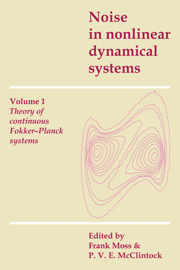Book contents
- Frontmatter
- Contents
- List of contributors
- Preface
- Introduction to Volume 1
- 1 Noise-activated escape from metastable states: an historical view
- 2 Some Markov methods in the theory of stochastic processes in nonlinear dynamical systems
- 3 Langevin equations with colored noise
- 4 First passage time problems for non-Markovian processes
- 5 The projection approach to the Fokker–Planck equation: applications to phenomenological stochastic equations with colored noises
- 6 Methods for solving Fokker–Planck equations with applications to bistable and periodic potentials
- 7 Macroscopic potentials, bifurcations and noise in dissipative systems
- 8 Transition phenomena in multidimensional systems – models of evolution
- 9 Colored noise in continuous dynamical systems: a functional calculus approach
- Appendix: On the statistical treatment of dynamical systems
- Index
2 - Some Markov methods in the theory of stochastic processes in nonlinear dynamical systems
Published online by Cambridge University Press: 05 January 2012
- Frontmatter
- Contents
- List of contributors
- Preface
- Introduction to Volume 1
- 1 Noise-activated escape from metastable states: an historical view
- 2 Some Markov methods in the theory of stochastic processes in nonlinear dynamical systems
- 3 Langevin equations with colored noise
- 4 First passage time problems for non-Markovian processes
- 5 The projection approach to the Fokker–Planck equation: applications to phenomenological stochastic equations with colored noises
- 6 Methods for solving Fokker–Planck equations with applications to bistable and periodic potentials
- 7 Macroscopic potentials, bifurcations and noise in dissipative systems
- 8 Transition phenomena in multidimensional systems – models of evolution
- 9 Colored noise in continuous dynamical systems: a functional calculus approach
- Appendix: On the statistical treatment of dynamical systems
- Index
Summary
Introduction
During the long development time of the theory of stochastic processes in nonlinear dynamical systems many approximate methods of calculation of various stochastic characteristics have been worked out for the Markov and non-Markov cases. There are two different equivalent approaches to the problem of the Markov case. Stochastic differential equations are used in the first approach, and the Fokker–Planck equation for time-dependent probability density is applied in the second. One must know how to pass from the stochastic differential equation to the Fokker–Planck equation and vice versa, so choosing the most appropriate method of solving the problem. Therefore at the beginning of this chapter we consider the rules governing the choice of method mentioned above and the different interpretations of stochastic differential equations are also considered.
It is a well-known fact that there are two basic interpretations, each of them having its own advantages. The first is the Ito interpretation. Using this interpretation one can easily write the drifts if the stochastic differential equation is known (generally speaking, the rules of averaging are simpler in this interpretation). This is the advantage of the Ito interpretation. The other interpretation is the S-interpretation. In it the stochastic differential equation is more simply transformed when the nonlinear change of variables is made, and the form of the stochastic S-equation coincides with the form of the pre-limit stochastic differential equation. This is the advantage of the S-interpretation.
- Type
- Chapter
- Information
- Noise in Nonlinear Dynamical Systems , pp. 16 - 71Publisher: Cambridge University PressPrint publication year: 1989
- 13
- Cited by



